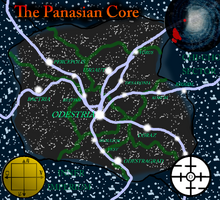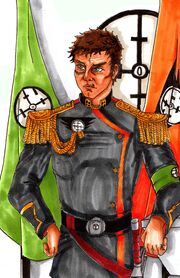In Emperator, In Imperium!
—The State motto.
The Odestrian Imperium (Panasian: Imperium Odestram) formally known as, the Imperium, Planets, and People of Odestria (IPPO) (Panasian: Imperium Planetus Populusque Odestram), also known as the Odestrian Empire, Odestria, and sometimes called Panasian Space; was a large interstellar galactic power existing in Wild Space and the Unknown Regions of the Galaxy.
For most of its existence, the Odestrian Imperium was governed by an enlightened autocracy under the control of the Emperor of Odestria. The state was made up of many races who inhabited the galactic south-west, the most dominant of of which was the Panasians, a near-human species that boasted extreme regenerative powers. The Imperium itself had been through many different eras numbered I to IV. At its height, the Imperium controlled thousands of worlds and held major holdings on 237 planets in the Unknown Regions. During the Rise of the Galactic Empire, the Imperium fought border skirmishes with the new state but the two superpowers remained in a steady and uneasy peace. The darkest time for the Imperium was the Yuuzhan Vong War where the Odestrians fought on the side of the New Republic and the greater Galaxy. They suffered heavily during the invasions, with widespread destruction to their military-industrial heartland and its most important planet, Chiev. Following the war, the Imperium fell into a decline causing the state to break out into various ethno-nationalistic conflicts which culminated in its disintegration.
History[]
Establishment[]
For as long as we can remember the Imperium has existed to protect the interests of the people of Odestria and those who fight for her.
—Lorekeeper Nicek Tokotov

The Panasian Core was unified under Sanatov's rule.
In the wake of the unification of Odestria under the banner of Odestre Sanatov, the Panasian people set out to unify the rest of the Panasian Core into a single entity. Following the unification of the Corps under the leadership of Sanatov, the new Panasian Union sought to expand its influence. Historical texts suggest that Sanatov’s force sensitive nature and seeming immortality, led to the cohesive nature of the Union. With the discovery of Hyperdrive, reverse engineered from technologies brought to Panas IV by Sanatov, the Panasians had managed to extend their new empire across nearby systems. To celebrate, Panas IV was renamed Odestria in honour of Sanatov and the lord declared the new state to be the Odestrian Empire.
Upon the discovery of a new hyperlane, the Panasian made their way to the planet Rah’Katov, a moderately advanced world populated by humans who had landed there in core-world sleeper ships, sent out thousands of years before. After a brief war with the Katovi, the Panasians successfully won and annexed the world into their empire. This is commonly known as the Great Joining, as this event marked the important union of Panasians and Humans, while also ending the relative homogeneity of the Panasian state.
First Imperium []
Main Article: Odestrian History: 5123 BBY - 4123 BBY
The First Imperium was a time of great expansion for the new empire.
—Nicek Tokotov

The insignia of the First Imperium, also known as the Sanatov family crest. This symbol would be used again later as the insignia for the Church of Odessan.
The first era of Odestrian history is known as the “First Imperium'' as per the Odestrian date classification. The early years of the First Imperium were focused on expansion into the Chaos, going rimward from the core. As well a push towards the core in order to add additional systems to the growing Odestrian empire. Although Hyperspace travel in the western galaxy was unstable, the Odestrians made use of force-sensitive cartographers to chart safe routes throughout the stars. Hyperdrives were mass produced and the entirety of the empire was pulled together into a program called the “Great Expansion,” historically known as the “First Great Expansion.” Vilikar Zamiliev, a mysterious alien found on Odyat, formed the Odestrian Legion from the feudal and decentralized Regiments of Panas. With this new military force, the Odestrian state expanded dramatically, moving south towards the Barakian core and annexing the Barakian Fence with the rest of the empire..
In 5060 BBY, or the 63rd year of the First Imperium, Sanatov was betrayed by his disciples while leading a campaign. While this was first seen as a great crime, the disciples declared that Sanatov demanded to be killed in order to pass on into the force. With this, Sanatov was deified as the great lord Odessan, the prophet who brought the Force to the Odestrian peoples. This began the Rule of the Disciples which would continue until the end of the First Imperium.
The first major event to occur during this period was the Republic-Contact War, when Odestrian scoutships came into contact with the Galactic Republic. The war was short, with it consisting of a few space battles and the occupation of N’zoth, the Republic and Odestrian governments agreed to a truce and eventual peace treaty.
The years following this saw the rise of Josef Xervov rise to the rank of Imperator. Under his nationalistic and oppressive rule, Odestrian society began to decline with power being focused in the hands of the Imperator and the noble houses of Odestria. This period saw the Second Great Expansion occur in the years following and after a little over 60 years, the Odestrian borders began to encroach on the nearby Nickian Expanse.
In 4143 BBY, the Odestrian empire made the push to annex the Hudrons of the Nickian Expanse into the Odestrian state. However, the Hudrons were adamant about remaining independent and refused the offer. More talks ensued but these also ended up breaking down and the two sides broke out into a war. The Odestra-Nickian War was the first major conflict fought by the Odestrians against an organized external power. While not an overly large conflict in terms of galactic scale, the war was brutal and costly. It was fought on 5 planets which bordered the Nickian Expanse and was marked by attrition warfare, pointless space battles and grueling ground combat. For 20 standard years, this war was fought, chewing up the lives of Odestrians and Hudrons alike. Whenever peace talks were attempted, Xervov intervened, adamant that the war would end with the total destruction of the Hudron race. The pointlessness and overall attitude towards the war severely affected the Odestrian populace on several planets, resulting in massive protests and riots. Mass desertions on the front line became commonplace and in the closing days of 4124 BBY, the Odestrian Legion ceased combat operations against the orders of Imperator Xervov.
The Odestrian Revolution and the Second Imperium[]
Main Article: Odestrian Revolution, Great Imperium War

Ardek Blezzus was a central figure to the re-establishment of the Imperial system.
The effective disintegration of the Odestrian Empire was followed by the Odestrian Revolution. This would see massive changes to Odestrian society and a push away from the quasi-feudal agreements which kept the old Imperium together. As an Imperial state was reconstituted following an interregnum, the Second Imperium would see the creation of a Federal system which led to the decentralization of Imperial authority. For a time, this system would lead to the most stable period in Odestrian history since the time following the First Great Expansion. The Imperium would then set out on its Third Great Expansion and begin to establish a foothold on the Galactic Rim.
This peace was short lived, as the Imperium was beset by economic difficulties which would eventually result in the deterioration of Imperial authority. This would eventually lead to the secession of the Barakian Fence and ultimately, the Great Imperium War. The War spelled the end of the Second Imperium, with its costs resulting in the destruction of much of Odestria’s surface as well as the collapse of the government.
Third Imperium and the Genzzus Wars[]
I think the Third Imperium has gained a terrible reputation due to what came after.
—Unknown

Panokkus Genzzus worked tirelessly to re-establish the Imperium.
Following the conclusion of the Great Imperium War, the Third Imperium saw a near continuation of the Federal system and the continuation of a semblance of Parliamentary democracy. In the wake of OdestraRak, Odestrian society underwent a massive shift as lines between military and civilian institutions began to blur. Panokkus Genzzus attempted to maintain a democratic nation, much like the previous government. However, Odestrian society continued to splinter and the Third Imperium was marked by almost constant internal and external conflicts. A revival of the Fence Confederacy was followed by a Humanocentric rebellion on Rah’Katov. This would be followed by a brief border war with the Chiss. Panokkus Genzzus would abdicate the Silver Throne in favour of his son, Jeffus and the wars would slowly calm. The Csillian Disorders marked the final major external issue until the Tri Decim Humilitus.
Tri Decim Humilitus and the Great Odestrian Civil War[]
Main Article: Tri decim humilitus, Darth Dajivan
By 3747 BBY, an upstart had risen within the Odestrian Senate who would eventually lead a series of events which would culminate in the Tri Decim Humilitus (Three Decades of Humiliation). Unbeknownst to the majority of Odestrian society, this man would be Darth Dajivan and his machinations would eventually end in the death of the final Emperor of the Genzzus dynasty, Kilev I. As Prima Consul, Dajivan used his sway over the Odestrian populace to take the position of Imperator and centralize authority of the state around himself and a secret cult of Sith and loyalists dubbed the Odestra Guard. His rule would result in the Odestrian Imperium being split between his faction and that of the Odestra Knight Panarus Kopan, who had initially been selected as Kilev Genzzus’ successor.
As the Great Odestrian Civil War raged on, Dajivan would decide to invade the Republic, attacking Commenor and causing the Republic to back Kopan’s faction and invade the Imperium. In the end, Dajivan would be killed by Oruth Teranee and his regent, Felix Karistad (Darth Alphus) would be killed in single combat by Kopan.
The Third Imperium ended when Dajivan took the throne but some argued that his Sith state was just a warping of the Odestrian nation, still under the Third Imperium. During the Treaty of Commenor, there was discussion to disarm the Odestrian state and keep it divided, however, Kopan’s rule would eventually end all discussion of a total demilitarization.
Fourth Imperium[]
The Fourth Imperium saw the Odestrian government shed the intention of democratic order, instead ensuring that it remained an autocratic state with an autocrat limited by a constitution. Kopan’s early reforms saw the state nationalize much of its industry in an attempt to repair the damage done by the war with Dajivan. While Panarus himself attempted to maintain distance from any sort of regal appearance, his son, Darius would not follow the same path. Taking the Throne following Panarus Kopan’s death in 3681 BBY, Darius led the Imperium as a strict autocrat, centralizing all power around the Silver Throne and initiating public works across numerous Odestrian worlds. He was also keen to silence any criticism to his rule and would frequently ignore advice from the Senatus. Darius would lead the Imperium through the Chaos Theater of the Great Galactic War. Emboldened by the Sith Empire, the Shiak’k Theocracy, a small nation, invaded the Imperium and cut a swath through the Imperium’s Industrial worlds, eventually threatening Odestria itself. While the tide would turn and Odestria would win, annexing the Theocracy in the process, Darius would eventually be diagnosed with Vetorum Disease and be killed by his Shadow.
His successor, his sister Tessania Kopan, ruled as the first female Empress of the Imperium. She would lead the nation through the war with Zakuul and the cooling of relations with the Republic. Eventually, relations would be cut off in favour of internal development.
From 2500 BBY to 2400 BBY, the Odestrian Imperium would project its power across the Chaos, leading to the Second Pax Odestra. Eventually however, the Great War of the Chaos would see the Odestrians and Chiss face the Vaagari. This would ultimately end with the Odestrians decimating the Vaagari homeworld resulting in the species adopting a more nomadic society.
Millenia of Stagnation[]
During the New Sith Wars, the Odestrian Imperium began to stagnate. As the Republic collapsed, the Imperium found its ability to trade lessen and eventually, even the most basic relations with the Republic would cease. This would only change following the Ruusan Reformations and in 990 BBY, relations between the Imperium and the Republic would continue once more. However, the Odestrian state was still in decline as the centralized economy was failing. In 989 BBY, Felix Kopan initiated massive administration reforms which saw the Over Sectors and Tribunates gain new governing powers in an effort to devolve the central authority. However, power was still largely concentrated on Odestria.
In 886 BBY, the Odestrian economy would be dealt a serious blow when one of its main energy producers, Obesnobyl suffered an ecological and astronomical catastrophe which effectively crippled the Odestrian energy sector in the Outer and Inner Imperium. This resulted in more energy needing to be imported from Outer Rim worlds as well as from the Republic. In 200 BBY, a Plague saw the need to sterilize the Shiak’k Sector and the hub world of Cosengrad was rendered uninhabitable.
In 180 BBY, Panarus XIV was crowned Emperor and established the “New Colonial Authority” which would allow for easier access to expansion.
The Clone Wars and Rise of the Empire[]

Traxus Kopan III was the final Emperor and Autocrat of Odestria under the Kopan name.
In the years leading up to the beginning of the Clone Wars, relations between the Imperium and the Republic were the best they had ever been. The Vanguard of Odestria, the office which allowed for joint-state communication, was occupied by Panok Reggim, who had been a friend of the Emperor Traxus III, was popular both in the Imperium and in the Republic as he had been a Jedi Master. When the Separatist Crisis began, the Imperium quickly took the side of the Republic and condemned the Separatists. As a result, Barakian and Sevain secessionist movements were fueled and Sevi VI, a planet that was largely different from the traditional Odestrian culture, revolted and faced another insurrection. While Traxus kept the Odestrians out of the Clone Wars, he deployed the Xth Legion to Sevi to quell the violence, ultimately leading to the Odestra-Sevi War.
As the Clone Wars ended and the Galactic Empire took the place of the Republic, the Odestrian state was cautiously optimistic about the state of relations with the new government. This was short lived as in 18 BBY, the Panarum Affair would almost lead to the Empire and Odestria going to war. Following the Treaty of Bakura, a DMZ was set up and a neutral zone was established at the southern zenith of both nations.
The Regency and Further Decline[]
2 BBY would see the end of the Kopan dynasty’s 3000 year rule over the IPPO. Traxus Kopan would suddenly die and his place would be taken by a collective regency as per the constitution. However, power would eventually centralise under Cassius Brusilov, the Representative for the Odestrian Legion on the OdestraRaad. Brusilov would lead to the establishment of the more stable Regency Council in which a First Chairman would serve as the head of state. The war on Sevi continued to deteriorate and relations with the Empire would also become dangerously cold.
By 4 ABY, the Galactic Empire collapsed and the IPPO would establish relations with the New Republic.
The Imperium would suffer terribly during the Yuuzhan Vong War, with the Vong leading a major offensive into Odestrian space and laying waste to its major industrial worlds. In the end, Chiev, the main trading hub of the Imperium, was rendered uninhabitable.
By 127 ABY, the Imperium, Planets and People of Odestria had all but collapsed into ethnic violence.
Government[]
In Odestrian society, one is told two things. Serve the State and Serve your family.
—Lorekeeper Nicek Tokotov
Executive[]

The State Emblem of the Odestrian Imperium.
The Executive branch of the Odestrian Imperium was split into two distinct entities. The first was the Emperor, who rule the state as a constitutional autocrat from the capital world of Odestria. The Emperor had the power to create and pass laws, promote planetary governors and dismiss anyone from their position save for the Odestrian Council (Panasian: OdestraRaad). The overtly autocratic nature of the Emperor was widely accepted throughout Odestrian space. This method of autocracy held great potential for misuse, and cases like these arose numerous times throughout the fourth Imperium in the years leading up to the Regency. The largest obstacle to potential tyrants was the Odestrian constitution: The
Charter of Imperial Service, which de-facto existed as an authority which superseded even the Emperor. Article I of the Charter highlights various reasons which could result in an autocracy to become “void”. Additionally, there was the post of “Emperor’s Shadow” which acted as both the Emperor’s bodyguard and hand. The position of Shadow was linked to that of the Emperor in that should the Shadow become incapacitated or die, the Emperor’s autocracy was to be voided. This was reciprocal as any shadow whose Emperor died, would be forced to resign the post and return to civilian life or join the Odestra Knights.
The second entity was the Odestrian Council (Panasian: OdestraRaad). This body was made up of representative from each Odestrian Over-sector: Panasian Core, Barakia, Inner Imperium, Outer Imperium, the Tri Colonius and Nitan. Before 200 BBY, there was a Councillor for the Shi’aak sector as well. In addition to these counselors, there is also several seats for military bodies such as the head of the Odestrian Civil Work Legion (OCWL). At the head of the Council was the Emperor. The council was largely advisory in running the Imperium however, the Emperor was required to deliberate on all suggestions brought up by the Council in regards to running the state. Should the Emperor be removed from the throne, the Council acts as a collective regency. When a new Emperor is chosen, the Emperor can choose to dismiss the council and create a new one. However, each new member chosen by the Emperor must be accepted by the previous member of the council, save for a few key members – like the aforementioned military councilors. This regency would be most notably enacted following the death of Traxus Kopan III during the Odestra-Imperial Cold War, from there the state was run by the council until the Silver Throne could be filled.
"Kopan Autocracy"[]
Main Article: Kopan Autocracy
The Senate often brings into question our relationship with Odestria. They see our alliance with such an autocratic nation as problematic. However these are trying times and the Odestrians have remained close despite our military discrepancies.
—Senator Sheev Palpatine to Viriliev Reggim

Panarus I Soter, the creator of "Kopan Autocracy."
Throughout much of the Fourth Imperium, the manner in which the state was run was via an absolute monarch sitting on the Silver Throne. This autocrat, styled Emperor and Autocrat of Odestria and her Imperium was given their power via the Odestrian constitution: The Charter of Imperial Service. Kopan autocracy was then a form of what scholars called “limited Autocracy” or constitutional absolutism. Should the appointed autocrat fail to adhere to the Charter their autocracy can be declared “void” by the Odestrian Council. This has only occurred several times throughout Odestrian history. However, due to the strong support for the Silver Throne and the established bureaucracy surrounding succession, the voiding of an autocracy has scarcely become a concern in Odestrian politics.
Legislative[]
It is the position of the Senate to formally recommend the Emperor on actions to be taken across the Imperium
—Article III of the Charter of Imperial Service.
The legislative branch of the state, was effectively the Emperor as well. However, based on the Charter of Imperial Service, “the Emperor acts as the Legislation in tandem with the advisory power of the Odestrian Senate.” This meant that, while the Emperor held the power to make legislation, the office was required to do so based on the choices from the Senate, which acted as an advisory body for the state as a whole. The senate as a whole was largely a holdover from the Odestrian Revolution and until the Tri Decim Humilitus, had full legislative power. In the wake of Dajivan’s reign, the Senate was depowered under Panarus Kopan, being effectively blamed for bringing Dajivan to power in the first place. Various Emperors have given the senate a variety of powers throughout their reigns. However, no Emperor specifically made the senate the official, all powerful legislative body of the Imperium. The senate was made of up representatives, offered by popular vote and chosen by the Emperor, in order to serve a 6-year term. Each major holding had a senator with lesser planets in their respective regions being given a “People’s Tribune” which formed the Senator’s “Tribune Cohort.”
Following the enactment of the current Regency, the Senate was granted effective legislative and governing power by the Odestrian Council until a successor for the Silver Throne could be found.
The senate met on Odestria or Odestragrad depending on the month of the Odestrian year.
Administrative Divisions[]
Unlike many other interstellar governments, the Odestrian Imperium was a unitary state with power centralized on Odestria. The state is divided on two levels. Much like the Republic and the Empire afterwards, the Odestrian Imperium was divided into 7, formerly 8, sectors. Each over-sector was given a councilor on the Odestrian Council as well as their own Over-sector legion to police and protect the space.
These over-sectors were the further divided into “Tribunates” these Tribunates were the unitary sectors of Odestrian space. As previously stated, each Tribunate is represented by a senator from that sector’s major world. Any other colonies within the Tribunate are given a people’s Tribune and act as a collective representative for the Tribunate as a whole. This body is known as the “Tribune Cohort.”
Foreign affairs[]
Odestrian foreign affairs shifted numerous times throughout the Imperium's long history. For starters, any sort of foreign interaction was handled by the Ministry of Diplomacy which tended to persue a "live and let live" policy. Given that the Imperium was largely self sufficient in terms of military and civilian manufacturing, there was no real need to establish importation or various trade agreements with other intergalactic powers, specifically within the Unknown Regions. However, this did not mean that Odestrian technology would not appear within galactic markets from time to time, with things such as the OLT-47b Heavy Blaster Rifle being available in markets outside the Imperium. There were many instances of the Odestrian Imperium forming military alliances with outside powers, the two most important being the Nickian Union and the Galactic Republic.
Nickian Union[]
The most important foreign relation the Odestrian Imperium had was with the small galactic power known as the Nickian Union. Since the Odestra-Nickian War of 4143 BBY, the Odestrians and the Nickians signed the "Treaty of Eternal Brotherhood and Friendship." Despite their societies being so vastly different from each other, the Nickians and the Odestrians have experienced very warm relations, with the exception of Darth Dajivan's annexation of the Nickian Expanse during Tri Decem Humilitus. The Treaty held between the Nickians and Odestrians is one of mutual friendship and also acts as a military alliance. However, this does not mean that if a power was to declare war on the Imperium the Nickian Union would be at war also, it simply means that were the Odestrians to ask for Nickian aid, there would be no choice but to say yes.
Galactic Republic[]
Main Article: Galactic Republic
Since their small contact war in 5053 BBY, the Republic and the Odestrians have shared rather cordial relations with each other, the largest example being the Vanguard program which saw the Odestrians send one of their own to act as an integrated envoy to the Republic. One of the largest situations in which the Odestrians and the Republic fought together was during the Great Galactic War against the resurgent Sith Empire. In this conflict the Empire controlled the religious Shi'akk Theocracy and created a brutal front which saw massive casualties for the Odestrians. The Odestrians managed to win in their theater of war, driving the Shi'akk back to their homeworld before devastating the surface as part of the Kalypsithenos doctrine. Following the annexation of the Shi'akk systems, the Imperium sent an Expeditionary legion to fight against the Empire until the Treaty of Coruscant. Following this, the Imperium kept up its relations with the Republic. However, foreign relations with the Republic stopped in 3630 BBY following the conclusion of the Zakuul War. In this instance, the manner at which the Republic renewed its war with the Sith Empire led to the Odestrians withdrawing to their sector of the Galaxy and not resuming relations with the Republic until after the Ruusan Reformation. In the wake of the New Sith Wars, the Odestrian Imperium once again resumed relations with the newly pacifist Republic, in fact relations became better than they had been prior to the New Sith Wars. During this time, the Odestrians created the "Vanguard Program" in which a member of House Reggim would travel to and live within the Republic as an envoy, the most famous of these was the Jedi Master Panok Reggim.
Galactic Empire[]
Main Article: Odestrian-Imperial Cold War
In the wake of the Clone Wars and the proclamation of the New Order, there was massive tension between the Odestrian Imperium and the newly minted Galactic Empire. Initially, the Imperium attempted to approach with the same manner of diplomacy that they had met the Republic with. This broke down as there was dislike for the Odestrian neutrality during the Clone Wars. What started off as simple border world disputes ended up escalating into a few small proxy wars in the Kotavi Star Cluster. This was until the Treaty of Varaktum, which created a steady peace between the two powers. While the Empire would end up encroaching into the Imperium with the Dark Matrix Crisis in 6 BBY, there was little to no contact between the two states during the Empire's brief control over the greater Galaxy. Additionally during this time, the Imperium began to no longer use the Imperial adjective with a lot of state institutions, the term Imperial being replaced with "Imperium" or "Odestrian." The most prevalent two changes was the change of the "Imperial Senate" to the "Odestrian Senate" and the "Imperial Council" to the "Odestrian Council."
Organization[]
Bureaucratic, organized, and efficient
—Third Imperium Panasian proverb.
Administration[]

The State Flag of the Odestrian Imperium
While the Silver Throne held virtually all the power within the Imperium based on the Charter of Imperial Service, much of the day-to-day administration of the Imperium was devolved to the massive bureaucracy which lay beneath the office. There were various political organizations in place which sought to enhance the dominant Odestrian ideology across all the planets of the Imperium, ensuring that the dominant culture of the Imperium was in place to ensure that the state was unified on that font. The Ministry of Odestrian Defense (Ministras OdestraOdesi) was the largest organization which served as an umbrella to other defense organizations such as the Justicarum and the Frumentarium. Arguably, the ministries of the Imperium were one of the most decentralized parts of the Imperium bureaucracy
Ministries[]
The various institutions of the Odestrian government were handled by the various imperial ministries (Panasian: Ministras Imperio) which made up the bulk of the Odestrian bureaucracy. While the senate and the executive council were responsible for the legislative recommendations to the Emperor, the ministries were responsible for the smooth running of the Imperium in all aspects. Under the charter of Imperial Service, the Emperor still held supreme autocracy over the Odestrian government, able to dismiss ministers at his leisure. However, under the tenants of the charter, the removal of a minister needed to be defended to the Odestrian council in order to ensure that the act was not one done out of selfish or tyrannical desire. The ministers together make up the Ministerium, a council made up of the ministers in order to centralize their decision making. The head of the Ministerium has a seat on the Odestrian Council and acts as an intermediary between the Emperor and the Ministerium.
The ministries which made up the Ministerium were as followed:
- Ministry of Wartime Production
- Ministry of Armaments
- Ministry of Odestrian Defense (Ministras OdestraOdesi)
- Ministry of the Legion (Government representation of the Imperium Legius Odestram)
- Ministry of Economics
- Ministry of Internal Affairs
- Ministry of Diplomacy
- Ministry of Expansion and Development
- Ministry of Culture and Education
- Ministry of Colonial Affairs
- Ministry of Colonial Defense
- Ministry of Justice
- Ministry of Health and Nutrition
- Ministry of Science, Technology and Advancement
Law Enforcement[]
Main Article: OdestraOdesi
Law Enforcement across
the Imperial was handled at various different levels and by numerous different organizations across the different planets of the state. Planetary police
forces were known as “Security Legions” which functioned as both military and civil
police forces. Like all major non-military organizations, the Security Legions
were under the direct command of the Odestrian Legion, specifically, the OCWL
of which the Security Legions were part of. During peace time, these forces
were more akin to civilian police, with any major judicial or safety issues
being handled by either SWAT teams or the OO-Justicarum. The latter of which
handled the more heavy-duty operations on planets with severe security issues
such as Sevi VI.
The aforementioned OO-Justicarum functioned as the Odestrian internal security agency and as such, acted to preserve the security and stability of the Odestrian State. Justicars functioned as both intelligence gathering operatives as well as a sort of pseudo-secret police force, especially on Odestrian worlds which suffered from consistent levels of separatist descent. The presence of Justicars on these worlds would increase in numbers until a situation would be deemed serious enough to take proper military actions. If required, the Justicarum’s administration has the tools to act as an effective paramilitary should the need arise.
Judicial Branch[]
Ahh... Odestrian Justice...
—Captain Darius Vrosev
The judicial branch of the Odestrian Imperium had two components. The first of these was the High Imperial Court, a largely civilian judicial system which was mainly focused on justice for crimes in the public sector of life. The HIC was placed under the direct control of the Ministry of Justice. At the head of the court is the Head People’s Justice, a post which is further supported by a council of six other appointed-for-life justices. The HIC acted as the highest court in the Imperium with member worlds being granted their own variants based on the structure of the HIC. Largely based on logic and the rule of law, the HIC was to ensure that the security of the Odestrian state was upheld based on the principals of the Charter of Imperial Service.
The second component was for military matters, this judicial component took the form of Military Tribunals. The tribunals were created as a means to bring justice to any military matters and given the virtual stratocratic nature of Odestrian society, the Tribunals held almost as much power and authority as the HIC. Throughout the Fourth Imperium era there had been numerous issues and points of contention between the HIC and the Tribunals, mostly due to the high levels of cohesion between civil and military bodies and issues which would often lead to certain levels of confusion in terms of case classification.
Military[]
It is the might of the Imperial Odestrian Legion which keeps the various worlds of the Imperium together. It is far from a simple military force, to the Odestrian Imperium, the Legion is a way of life, something that has a hand in every Odestrian citizen's development
—Battlemaster Carlyle Durmont

The Odestrian Legion insignia
The Imperial Odestrian Legion was the foundation of Odestrian society. The Military functions as not only the peacekeeping force, but has a role in virtually every part of Odestrian society, from firefighting crews to the civil police force. Although the Imperium itself was much smaller than the Republic in its heyday, the Odestrian military still had formidable discipline. Officers and NCO's dedicate their lives to the Legion, being known as Tenrakus meaning "To the death" in Panasian. Conscripts and enlisted personnel are trained from the day of initiation that to remain calm under fire is the key to winning a battle. Odestrian battle formations rarely break and if they do it's because the unit has been wiped out. This current form of doctrine has been used since the days of the Third Imperium and saw refit during the initiation of Panarus Kopan Soter’s reign in 3725 BBY.
Boot camp starting when a citizen reached the age of 16. Every citizen must do this military service for at least 15 to 25 years, when this is up, they can choose to be part of reserves, continue their service and take officer training or join society as a civilian, starting a business and raising a family. The service time is dropped for Twi'leks and Humans, instead lasting only 5-10 years as their lifespans are only half of a Panasian.
Army[]

"Keeping Sevi Safe for All" was a Propaganda poster advertising to join the Xth armored Legion on Sevi VI during the Odestra-Sevi War.
The Odestrian Ground Legions was the army wing of the Odestrian Legion and the strongest and most feared aspect of the Odestrian Legion. Legionaries typically wore heavy Silver armor with Odestrian insignias and carried Heavy Blaster Rifles into combat. Legionaries are often trained on Odestria on the continent of Ofortus. There they go through rigorous training and heavy discipline in order to ensure the safety of the Imperium. Non combatants in the Ground Legion are also trained to use small weapons so that they do not remain defenseless. One of the major aspects of the ground legion is its near lack of automated infantry. This is due to the reforms of Darius Kopan I and the strong sense of civic duty which exists in many Odestrian citizens. the use of droids is looked at as cowardly and dishonorable and the Legion prides itself on making fine soldiers out of the Odestrian populace. The ground legion does make use out a verity of vehicles in order to make surface attacks plausible. As fearsome as their numbers may be, sending waves of infantry at enemy walkers would be a meaningless sacrifice. The armor composition of the Legionaries would change following the Fourth Imperium but in the wake of the Odestrian-Zakuul War in 3635 BBY, the design of the OL-387B Legion Armor would become a mainstay. The armor was heavy in design but the mixture of Durasteel and Plasteel in it's surface made the armor lighter to wear as iterations came and went. In addition to their armor legionaries carried their rifle, a sidearm, an emergency medpac, 7 days worth of field rations, emergency energy cells, and Grenades in their battle packs.
The Odestrian Ground Legion rank structure was as follows. Private (Privatus), Special Private (PrivatusSpectum), Corporal (Corpuris), Sergeant (Sargentas), Junior Battlemaster (JuniusBatteaus), Lieutenant (Litaenus), Captain (Caustan), Battlemaster (Batteaus), Junior Legate (JuniusLegatus), and finally Legate (Legatus). Special additions and ranks included, Field Legate (LegatusYeldus), and Supreme Imperial Battle Master (SupraBatteausImperium)- reserved for the Commander-in-chief of the Legion.
[]

The Insignia of the OdestraNav
The Imperium OdestraNav or the Imperial Odestrian Navy was the naval branch of the Imperial Odestrian Legion. It was overseen by the Minister of War, the Imperium Fleet command and the Emperor/Empress, who controlled the entire Legion. OdestraNav ranks are as follows: Private (Privatus), Fleet Private (PrivatusNav), Corporal (Corpuris), Junior Officer (JuniusOffica), Junior Battlemaster (JuniusBatteaus), Lieutenant (Litaenus), Captain (Caustan), Group Battlemaster (BatteausRegato), Fleet Legate (LegatusNav), Admiral (Admirus) and finally Fleet Battlemaster (BatteausNav). Ships in the OdestraNav are produced at Chograd Ship Yards and tends to consist of Dreadnoughts, Cruisers, Frigates and Destroyers. In the tenure of the Imperium, the ships used by the OdestraNav have changed but two mainstays existed during the long tenure of the Fourth Imperium. First, the Tempest-Class Cruiser was among the most well known of the Odestrian fleet, the overall design being used since the Third Imperium and the Second Fence War.The Tempest-Class made up the bulk of the OdestraNav but it was not the strongest part of the Fleet. The vessel to fit that role was the Infernal-Class Superdreadnaught. These massive vessels where 17000 meters in length held a crew of 189 240, along with a passenger compliment of 25000. Starfighters in the OdestraNav also went through variations during the Imperium's tenure, fighters like the O-1 Heavy Starfighter, the ATB "Z-wing" Fighter and the F-X16A "Silverwing" Interceptor are among some of the more well known fighters. The OdestraNav also made use of O-2 Heavy bombers and a verity of assault crafts, shuttles and cruisers.
Economy[]
You really must know by now that Chiev is the center of the Odestrian Economy.
—Unknown Odestrian Senator

The symbol for the Odestrian (Kopan) Kpsul.
The Odestrian currency was known as the “Kopan Kpsul”, it existed as both a physical currency and a digital currency. It exchanged for approximately .8 of an Imperial Credit around 0 ABY.
When Panarus Kopan created the fourth Imperium in 3725 BBY, he had Milchev Volsi, the Minister of Economics, devise a state-run, centralized economy in order to create an organized system, preventing more chaos from sweeping over the already damaged Odestrian systems. Following the Tri Decim Humilitus. Key industries like Troisec, Chograd Shipyards and ZeniTech, were nationalized in order to prevent corporations from reaping the benefits of a beleaguered people. Furthermore, the plan was to establish self-reliance within the darkness of the Unknown Regions. To Kopan’s new Odestria, they had to rely on foreign systems for essential supplies too many times, and that costed them dearly. By the time of Panarus Soter’s death in 3681 BBY, the Odestrian Imperium neared total self-reliance, using the various resource rich systems within their borders to provide the state with everything it needed.
Following the economic reforms of Darisev Mulaire in 989 BBY, the Odestrian economy began to liberalize. While still highly centralized, renewed peace with the Republic meant that the Odestrian state was able to trade with a new power. Economies diversified on a planet to planet level rather than remaining centralized at the state level. Planetary economies were bolstered while at the same time, the state as a whole benefited.
Society and culture[]
Odestrian society can't be limited to the scope of a single planet. Indeed, it should rather be extended to all the worlds which fall under the Odestrian flag.
—Unknown
Odestrian society had existed, at least on Odestria, for millennia. As an Imperial culture, Odestrian society was coverted into its stratocratic state following the Kopan Reforms of 3724 BBY. This was then amended following Darius Kopan I, reforms in 3654 BBY which effectively set the stage for how the Galaxy saw Odestrian society. From an outside perspective, the Odestrian society was largely seen as an autocratic society which strictly adhered to conservative tradition and followed a rigid code of ethics and civil duty. Panasians were seen as having a cultural hegemony over the rest of the species in Odestrian space, leading to the idea the Panasians were a fascist race, using their cultural dominance as a means of committing cultural genocide. In truth, Odestrian culture was the result of a long amalgamation of Panasian, Human, and Barakian culture which eventually began to take aspects of various other member races within the Imperium. While the society was taught to think of itself as homogeneous, the individual was still present. While Odestrian society was geared towards collective purpose, people were still free to live their lives how they wanted to, so long as it did not endanger the state. This ideology became known as Livio In Imperium.
Odestrafication and Livio In Imperium[]
Main Article: Odestrafication
In larger more decentralized galactic societies like the Republic, overly centralized administration was impossible due to the drastic differences between the millions of sentients and thousands of worlds. Odestrian centralization was only made possible due to the nature of the Unknown Regions as well as the circumstances in which the sentients on the habitable planets in Odestrian Space came together. When the same manner of Odestrian-inspired centralization was attempted by Palpatine’s Regime, it ended up leading to the formation of
the Alliance to Restore the Republic as well as a drastic mismanagement of the galactic government. Odestrian society differed by its total subservience to the state and society which is instilled throughout all Odestrian youth, regardless of species, from the day they are born; this is known as Livio In Imperium (Life for the Imperium). Under this ideology, Odestrians were taught that no one was above another and that everyone was equal under the Charter of Imperial Service. Civic duty and Self-sacrifice were at the forefront of this ideology and it allowed for society to effectively take the militarized, meritocratic form that it kept for millennia. This thinking also led to the reduced potential in civil dissidence and rebellious behaviour in youths and intellectuals. The Odestrian autocracy was presented as enlightened and constitutional and the state was almost patronymic in nature. As a result, it held up a virtually unmovable legitimacy even lasting into the Regency.
The doctrine of “Odestrafication” had also been a tremendous success in terms of Odestrian annexation policy. Odestrafication was the conversion of a planet’s architecture and society into a mirror of Odestria. This was meant to bring other planets into the Odestrian sphere, effectively making “all planets Odestria.” Despite the move from expansion to fortification following Kopan’s accession in 3725 BBY, the policy of Odestrafication had lasted the millennia since Panokkus Genzzus and proved to be the best ideology in crafting Odestrian space into, what the Odestrian government called, an interplanetary nation-state. This was expanded upon following Panarus XIV's establishment of the "New Colonial Authority" during his reign, leading to the increase of new settlements on uncharted planets within Odestrian space.
Place of the Military[]
In Odestrian society, the military took precedence over all aspects of life. The Odestrian Legion was not just a fighting force, but a massive bureaucratic civic works organization which was fully integrated into all state institutions. Institutions which would normally be planetary civilian bodies: Police, Fire-Department, civil-servant and government workers, were all arms of the Odestrian Civic Work Legion (OCWL). Enlistment was mandatory for men and optional for women at the age of 16 as part of Odestrian education, this meant that entering the workforce was also considered a form of Imperial service.
The militarization of society, often considered part of the overarching “Odestrafication” ideology, had its origins during the late Revolutionary period, following the Blezzus reforms of the republic phase of the Imperium. It had initially started as a means of equalizing society, which had been largely caste divided under the feudal “house” system. While the House system still exists in a ceremonial sense, the overarching concept of nobility was virtually eradicated following the Kopan reforms of 3724 BBY. In this case, military service exists to complement the doctrine of Livio in Imperium, with the military’s place serving as a foundation to the concept of Odestria as an intergalactic nation-state.
Education[]
In Odestrian society, schooling begins at age 5 and goes until the age of 15. From 15, the military takes over education as well as providing basic training and civil management. Early schooling or Prima Educas teaches children: language, literature, Math, basic physical training, art, writing and religion studies. The military education or Dicus Educas teaches youths: History, Political science, advanced physical training, sociology and astrography. The basic arts are front loaded so that children are given a short, strong education before moving on to military schooling. Teachers at the Prima level are well-trained and have the Odestrian equivalent of a masters degree, the teachers themselves have also served in civil military service as to ensure that the militaristic values of the Odestrian state are preserved and passed on to the next generation.
Demographics[]
Regardless of the planet in which you were born, we are all Odestrians.
—A common saying.
The Odestrian state identified itself as a multi-racial state, unified under a single society and cultural identity. There were numerous various species which lived in the borders of the Odestrian state, the most of which being the Panasians. Panasians dominated the Panasian Core as well as several Tribunates within the Inner-Imperium and Chi-Cho sectors. Humans were the second most common species in the Imperium. Humans mostly inhabited the Inner Imperium, centralized mostly on Rah’Katov and Sevi VI. Sevain humans proved to be the most culturally diverse of the human species within the Imperium, being granted the status of an Autonomous Tribunate in 170 BBY. Dispersed throughout Odestrian space was the Barakian species, once having been highly concentrated within the Barakian Fence. While the Fence still acts as the hub of Barakian activity, the cost of the two costly wars due to Barakian nationalism and military aggression has led to a large dispersion of the species throughout the Imperium. Twi’leks were also a common minority within the Imperium with Odestrian Twi’leks making up the fourth highest population within the state; mostly concentrated on the border between the Panasian Core and the Chi-Cho sector on their world Selicus.
With the number of planets in the Imperium, there were thousands of alien species who were approached to join the Odestrian community. In cases like the aforementioned Sevi, the native Sevish peoples seemed reluctant to join the Imperium. This led to cultural and technological segregation known as Temika which allows the native populations of planets to largely govern themselves, paying little service tax and being exempt from off-world Legion service.
Prior to the sterilization of the Shi’akk Sector, the Shi’akk species were divided following the annexation of their sector following the Great Galactic War’s Western theater. Some Shi’akk chose to serve the Imperium, amalgamating culturally and religiously into the state. Others chose to take the path of the Sevish and separate themselves from Odestrian affairs, causing most of the Shi’akk species to relapse into a post-space travel society which some argue, contributed to the eventual plague which led to the sector’s sterilization.
Infrastructure[]
Transportation[]
Given the unitary nature of the Odestrian state, vast amounts of transportation networks were put in place in order to move both civilian and military personal across the usually unstable network of unknown region hyperlanes. Much of the Odestrian transportation network was focused around the vital trans-imperium highways known as the Panasian Trail and the Imperium Hyperway. From here, several offshoot routes were mapped into the inner heartland of Odestrian space, thoroughly connecting all major holdings within the Odestrian state. Similarly, to the larger Galactic Empire, smaller colony worlds in the Odestrian Imperium had hyperspace beacons in their government districts or located somewhere in the system. This allowed for the OdestraNav to rapidly deploy to a system if it needed assistance. In addition to this, the beacons acted as a sort of addition to the already vast Odestrian hyperlane system which had been carefully woven throughout the Galactic West over millenia.
Certain planets which lacked any livable conditions were turned into resource worlds or storage worlds. These planets acted as storage hubs for trillions of tons of supplies and resources which would be shipped throughout the Imperium when needed. Cargo freighters, usually owned by the OCKL were used in order to ship these supplies and resources across the state.
Closer to the border systems of Odestrian space were the various mining stations and jails which aided in punitive measures against the Imperium’s criminals. The largest of these was the penal world Purgatorious, which sat on the very edge of Odestrian space, deep within the Barakian Fence.
Communications and Media[]
The communication networks which stretched across the Imperium were similar to those of the greater Galaxy. The communication network originally existed as an arm of the greater galactic holonet, however following the collapse of relations between the greater Galaxy and Odestria, the two services divided. This new network, known as the OdestraNet, was a state-run network which functioned mostly as a propaganda machine during its early years. However, following the rule of Darram Kopan II, the OdestraNet liberalized and several private channels became available like Vanida’s Home baking and Sevi Planetary News Network. Still, the largest broadcaster was the BCO (Panasian: Brodica Cimil Odestram) or Odestrian Broadcasting Company (OBC). The BCO held shows like ONN (Odestrian News Network) and various other state-run media.
Astrography[]
Main Article: Odestrian Space
There were many different powers present in the "Unknown Regions" as the Arijin called them. The Odestrians presented one of the largest armed forces in the Galaxy, something which they used, not for conquest, but for the betterment of their growing society.
—Lorekeeper K'Krell Tokotov

A political map of the Odestrian Imperium prior to the Sterilization of the Shi'akk sector.
The Fourth Imperium had existed for over 3 millennia around the time of the Clone Wars and the Rise of the Empire. With this in mind, the state’s astrographical borders shifted multiple times throughout the many years of the fourth imperium. Each major inhabited planet was fully integrated into the Odestrian state via the process of Odestrafication, in this regard many if not all planets that remained within the imperium considered themselves “Odestrian” plainly or as an adjective to their native planet’s demonym.
The Imperium had reached its territorial peak around 2000 BBY following the Great War of the Unknown Regions and its rise to superpower status within Galactic West at which point it controlled hundreds of thousands of star systems, having major holdings on over 150. As the New Sith Wars ravaged the eastern galaxy in the next millennia, the Odestrian state began to steadily decline in territory, while still being in a state of relative peace.
At the time of 0 BBY, the Odestrian Imperium still controlled over 1,000 relatively inhabited star systems, their major holdings being reduced to simply 38 imperial worlds. The Odestrian planets were all documented in the Odestrian Imperial Astrographical library on Odestria.
Behind the Scenes[]
The Odestrian Imperium is the ruling body of the author's fanon Star Wars faction "The Odestrians." While initially thought up as a faction for playground games, the author ended up developing the Odestrians into a distinct group and then more of a fleshed out society. As time passed, the author used knowledge he had acquired about world building, societies and history to develop the Odestrian state and government.
The eventual "official" name of the Odestrian government, "The Imperium, Planets and People of Odestria" took inspiration from a few sources. These were namely the "Senate and People of Rome" (SPQR) and the Union of Soviet Socialist Republics (USSR); the latter of which used the shortened form "The Soviet Union" much like how the IPPO uses "The Odestrian Imperium."

